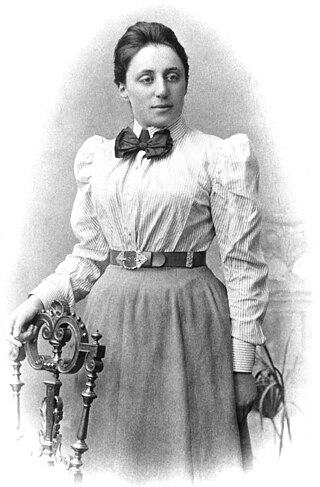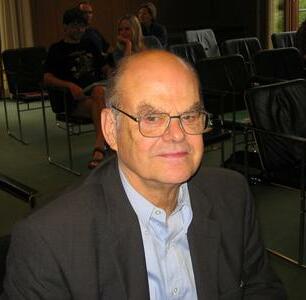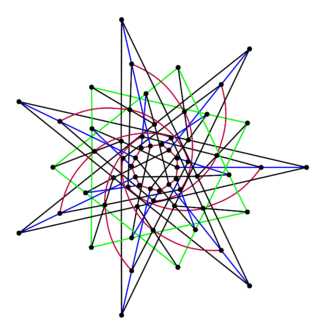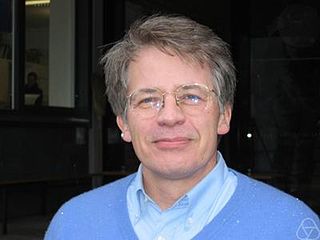
In mathematics, a simple group is a nontrivial group whose only normal subgroups are the trivial group and the group itself. A group that is not simple can be broken into two smaller groups, namely a nontrivial normal subgroup and the corresponding quotient group. This process can be repeated, and for finite groups one eventually arrives at uniquely determined simple groups, by the Jordan–Hölder theorem.

Amalie Emmy Noether was a German mathematician who made many important contributions to abstract algebra. She proved Noether's first and second theorems, which are fundamental in mathematical physics. She was described by Pavel Alexandrov, Albert Einstein, Jean Dieudonné, Hermann Weyl and Norbert Wiener as the most important woman in the history of mathematics. As one of the leading mathematicians of her time, she developed theories of rings, fields, and algebras. In physics, Noether's theorem explains the connection between symmetry and conservation laws.
In algebra, ring theory is the study of rings, algebraic structures in which addition and multiplication are defined and have similar properties to those operations defined for the integers. Ring theory studies the structure of rings; their representations, or, in different language, modules; special classes of rings ; related structures like rngs; as well as an array of properties that prove to be of interest both within the theory itself and for its applications, such as homological properties and polynomial identities.

In abstract algebra, a finite group is a group whose underlying set is finite. Finite groups often arise when considering symmetry of mathematical or physical objects, when those objects admit just a finite number of structure-preserving transformations. Important examples of finite groups include cyclic groups and permutation groups.
Invariant theory is a branch of abstract algebra dealing with actions of groups on algebraic varieties, such as vector spaces, from the point of view of their effect on functions. Classically, the theory dealt with the question of explicit description of polynomial functions that do not change, or are invariant, under the transformations from a given linear group. For example, if we consider the action of the special linear group SLn on the space of n by n matrices by left multiplication, then the determinant is an invariant of this action because the determinant of A X equals the determinant of X, when A is in SLn.
In mathematics, the Brauer group of a field K is an abelian group whose elements are Morita equivalence classes of central simple algebras over K, with addition given by the tensor product of algebras. It was defined by the algebraist Richard Brauer.

John Griggs Thompson is an American mathematician at the University of Florida noted for his work in the field of finite groups. He was awarded the Fields Medal in 1970, the Wolf Prize in 1992, and the Abel Prize in 2008.
In mathematics, Hilbert's fourteenth problem, that is, number 14 of Hilbert's problems proposed in 1900, asks whether certain algebras are finitely generated.

In mathematics, a generalized polygon is an incidence structure introduced by Jacques Tits in 1959. Generalized n-gons encompass as special cases projective planes (generalized triangles, n = 3) and generalized quadrangles (n = 4). Many generalized polygons arise from groups of Lie type, but there are also exotic ones that cannot be obtained in this way. Generalized polygons satisfying a technical condition known as the Moufang property have been completely classified by Tits and Weiss. Every generalized n-gon with n even is also a near polygon.

Robert Louis Griess, Jr. is a mathematician working on finite simple groups and vertex algebras. He is currently the John Griggs Thompson Distinguished University Professor of mathematics at University of Michigan.
In mathematics, the Brauer–Suzuki theorem, proved by Brauer & Suzuki (1959), Suzuki (1962), Brauer (1964), states that if a finite group has a generalized quaternion Sylow 2-subgroup and no non-trivial normal subgroups of odd order, then the group has a center of order 2. In particular, such a group cannot be simple.
Brauer's main theorems are three theorems in representation theory of finite groups linking the blocks of a finite group with those of its p-local subgroups, that is to say, the normalizers of its nontrivial p-subgroups.
In mathematics, Harish-Chandra's regularity theorem, introduced by Harish-Chandra, states that every invariant eigendistribution on a semisimple Lie group, and in particular every character of an irreducible unitary representation on a Hilbert space, is given by a locally integrable function. Harish-Chandra proved a similar theorem for semisimple p-adic groups.
In mathematics, the Chevalley–Shephard–Todd theorem in invariant theory of finite groups states that the ring of invariants of a finite group acting on a complex vector space is a polynomial ring if and only if the group is generated by pseudoreflections. In the case of subgroups of the complex general linear group the theorem was first proved by G. C. Shephard and J. A. Todd who gave a case-by-case proof. Claude Chevalley soon afterwards gave a uniform proof. It has been extended to finite linear groups over an arbitrary field in the non-modular case by Jean-Pierre Serre.

In mathematics, more specifically algebra, abstract algebra or modern algebra is the study of algebraic structures, which are sets with specific operations acting on their elements. Algebraic structures include groups, rings, fields, modules, vector spaces, lattices, and algebras over a field. The term abstract algebra was coined in the early 20th century to distinguish it from older parts of algebra, and more specifically from elementary algebra, the use of variables to represent numbers in computation and reasoning. The abstract perspective on algebra has become so fundamental to advanced mathematics that it is simply called "algebra", while the term "abstract algebra" is seldom used except in pedagogy.

Michael Jerome Hopkins is an American mathematician known for work in algebraic topology.

Jonathan Lazare Alperin is an American mathematician specializing in the area of algebra known as group theory. He is notable for his work in group theory which has been cited over 500 times according to the Mathematical Reviews. The Alperin–Brauer–Gorenstein theorem is named after him.
In mathematics, semi-simplicity is a widespread concept in disciplines such as linear algebra, abstract algebra, representation theory, category theory, and algebraic geometry. A semi-simple object is one that can be decomposed into a sum of simple objects, and simple objects are those that do not contain non-trivial proper sub-objects. The precise definitions of these words depends on the context.
Klaus Wilhelm Roggenkamp was a German mathematician, specializing in algebra.








